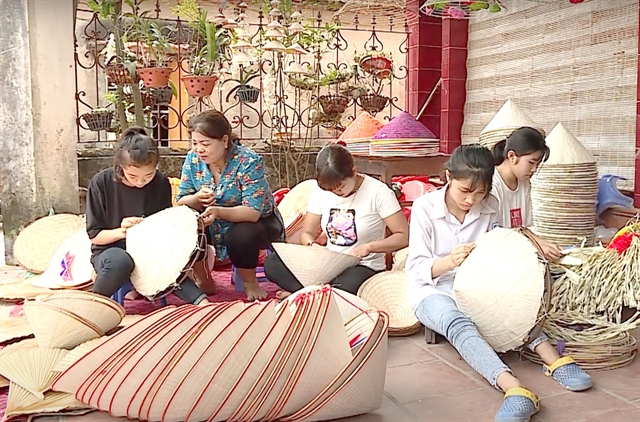 Society
Society

Some 1,700 people from 14 suburban districts and one urban district of Hà Nội have benefited from a project aiming at providing vocational training for young people in the suburbs of Hà Nội to help them get a stable livelihood.

|
| Young people in suburban Hà Nội districts attend a training course to make conical hat in Chuông traditional handicraft village. — VNS Photo Lê Đông |
Hồng Minh
HÀ NỘI — Two years ago when Nguyễn Ngọc Bình was 16, he wanted to do something to help feed his family.
His father had passed away some years before, leaving him the only man in the family with his mother and a younger teenager sister while the older sister had married and left home.
“At that time, my family did not have a stable income as my sister and I were at school while my mother just worked on our small rice field,” Bình said.
Like many other youngsters in Khôn Duy Village in Hà Nội’s suburban Chương Mỹ District, some 30km from the capital's centre, Bình did not have much access to job opportunities. He had no idea how he could start earning money.
Fortunately, he learnt about a vocational training centre in the neighbouring traditional handicraft village of Phú Vinh that offered free courses on making products from rattan and bamboo for local young people. Bình knew this was what he had been looking for.
He registered for a six-month-long training course with instruction from local artisan Nguyễn Văn Trung to learn weaving techniques using rattan and bamboo. After finishing the course, Bình was recruited to work at Trung’s workshop and now earns VNĐ3-4 million (US$130-170) a month by making the rattan and bamboo products.
“I have also taught my mother the weaving techniques so she can also make some products herself when she is not busy in the rice field and we can get some extra money from her products,” Bình said proudly.
Now 18, Bình knows he has a job that provides him with a stable income to help his family. He is also saving money for other vocational training in machinery.
Bình is among some 1,700 people from 14 suburban districts and one urban district of Hà Nội who have benefited from a project aiming at providing vocational training for young people in the suburbs of Hà Nội to help them get a stable livelihood.
The project, funded by the Citi Foundation, has been implemented since 2015 and has undergone five phases, which lasted 12 months each. After five years, the project has organised 52 training courses for young people in 14 suburban districts and one urban district Long Biên.
A representative for Citi Foundation, Citi Vietnam's Public Affairs Officer, Bùi Quang Huy, said young people suffered the most from the rapid urbanisation in big cities. One of the visible impacts was that they would find it more difficult to have jobs which are suitable for their education and training, Huy said.
The project aims to not only help the trainees get jobs and stable income but also to provide them access to better job opportunities and higher income to develop sustainable livelihoods, while contributing to the preservation and development of traditional occupations in Hà Nội.
A report from the project showed nearly 90 per cent of trainees got jobs after completing courses. They also get a stable income from VNĐ100,000-300,000 for a working day. Of those, wood carving has the highest income at VNĐ200,000-300,000 a working day.
Nguyễn Thị Thơm, head of the Women’s Association in Thanh Trì District’s Vĩnh Quỳnh Commune, said the training courses were practical for local young women, especially those in the countryside.
According to Nguyễn Bích Vượng, Director of the Centre for Microfinance and Development (M&D), the latest Phase 5 of the project, implemented from October 2019 to September this year, offered 15 vocational training courses for 350 trainees. The courses included seven main traditional handicrafts of hand embroidery, rattan and bamboo weaving, shell inlaying, pottery, wood carving, making conical hat and cooking with the participation of artisans from famous traditional handicraft villages as trainers.
In Phase 5, the project has also added training in starting a business so that young people in the countryside could learn about small business management.
“This year, due to the impacts of the COVID-19 pandemic, a number of courses have been affected,” she said, “However, thanks to the support from artisans as well as enterprises, most of the trainees still got job opportunities after finishing the courses.”
Artisan Nguyễn Thị Vui, Chairwoman of the Board of Ngọ Hạ Shell Inlaying Co-operative in Phú Xuyên District’s Chuyên Mỹ Commune, said that even if the pandemic had caused many difficulties for traditional handicraft villages, the artisans were happy to teach trainees as they really wanted to maintain enthusiasm for traditional crafts.
“If the class closed one day, the trainees would not be able to practise and would forget about what they learned, so we wouldn't have the next generation of artisans,” Vui said.
Vui suggested the project not limit the age of beneficiaries from 16 to 30 and offer more advanced courses for those who have finished basic courses.
Artisan in rattan and bamboo weaving Nguyễn Văn urged the project to find a way to help young people keep their enthusiasm for the occupations they were trained in.
Having joined in the project since the beginning, the artisan has opened dozens of courses for local young people, who he said were very skilled and creative.
“It is important to create favourable conditions for young people to have their own start-ups from the vocational training they got,” Trung said. — VNS




